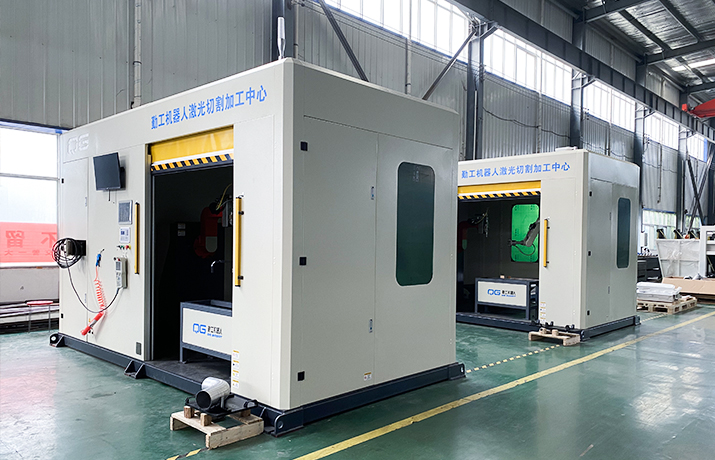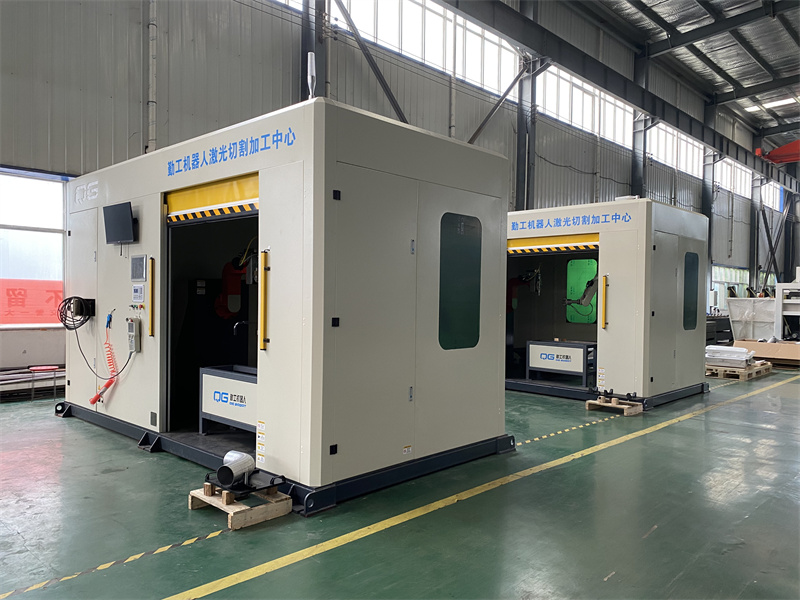News
Grasping the pulse of the industry and measuring industry trends
The application and development of industrial robots in the automotive manufacturing industry

In recent years, the rapid development of industrial robots has enabled the automotive manufacturing industry to achieve a highly automated and efficient production mode, which has greatly promoted the rapid development of China's automotive manufacturing industry to a certain extent. This article mainly elaborates on the application fields and future development trends of industrial robots in automotive manufacturing in China, focusing on three aspects; One is the application of industrial robots in the field of automobile manufacturing in China, the second is an objective introduction to the current development status of industrial robots in the automobile manufacturing stage in China, and the third is to elaborate on the future development trend of industrial robots in the automobile manufacturing industry in China. Intended to provide more scientific references for the application of industrial robots in the automotive manufacturing industry in China, and to help industrial robots better adapt to the development of the automotive manufacturing industry in the future.

The application of industrial robots in automotive manufacturing
At present, the application range of industrial robots in the field of automobile manufacturing is extremely wide. The application rate of robots in the four conventional workshops (stamping workshop, welding workshop, spraying workshop, and final assembly workshop) in the manufacturing production line is over 90%. Nowadays, China's automobile manufacturing continuously transforms and transforms every year, and robots are installed in all workshops that can use robots. For example, in 2022, Chengdu Lingke Welding and Assembly Workshop added 2 welding production lines to improve the equipment in the welding and assembly workshop. In the early stage of introducing new car models, the transformation of welding and assembly line workstations involved the addition of 30 robots. The automobile manufacturing workshop used robots to grab and transport plates and then buckle them. Robot spot welding, screw welding, laser welding, transportation, palletizing, assembly, spraying, and inspection were all automatically completed by robots. The use of robots greatly increased the automation level of the four major workshops.
Welding
In the welding production line process of automobiles, each production line is composed of a small workstation. The four door and two cover production line, as well as the lower and main lines in the welding and assembly workshop, are composed of subdivided workstations. Each workstation usually has 4-6 robots working together, and the welding workstation is widely used and distributed. As the production line advances, the white body is formed from the three main components of the front bottom plate, rear bottom plate, and engine compartment, which are assembled to the upper left and right A-pillars, rear tailstock, left and right side panels, four doors and two covers in the middle, to the rear sunroof. Spot welding and repair welding account for nearly 60% of the total. With the continuous progress and development of new technologies in robot welding, the application of robots in automotive welding production lines is becoming increasingly widespread, and the functions of robots in welding are gradually becoming more diverse. In the manufacturing of automobiles, spot welding and arc welding technology are commonly used for body welding. Before the robot performs body welding, it needs to be controlled by a PLC to transfer the sled in place and complete the descent. Then, the PLC triggers the corresponding program of the robot for the vehicle model, and the robot can start working. The entire process does not require manual intervention.
Handling and palletizing
The handling and palletizing of automotive parts is one of the key links in the automotive manufacturing process. In traditional manufacturing, handling and palletizing are mainly done manually. However, most automotive parts are large in volume and the plates are prone to scratching human skin tissue. If they are still manually handled, it will be time-consuming and laborious, with a high safety factor and easy to cause damage to the parts. Nowadays, the application of industrial robots for handling and palletizing can solve this problem. Robots can work without rest, with the advantages of not only fast speed but also safety. Robots can automatically complete handling and palletizing tasks according to pre-set programs. Therefore, in automotive manufacturing, the application of industrial robots in handling can not only reduce labor costs and the probability of safety incidents, but also reduce the workload of workers.
Spray coating
In the process of car painting and gluing, the application of industrial robots has obvious advantages. It can not only evenly spray paint on the car body, but also reduce the occurrence of safety accidents, effectively improve the speed and quality of painting and gluing. When painting, the main focus is on the surface of the car body, while gluing is the connection position between the various panels of the car body. Before gluing, the corresponding gluing equipment needs to be installed, including the heating temperature of the gluing machine, the glue barrel, and the glue gun. The gluing robot will apply glue to the connection position of the vehicle body according to the pre-set program. Due to poor ventilation in automobile manufacturing workshops, harmful gases in coatings are difficult to emit. If workers are exposed to this environment for a long time, their health will be seriously endangered. And spraying robots can effectively avoid this, as they can choose different spraying tools based on the shape of the vehicle and work according to pre-set spraying procedures. The use of spraying robots can not only protect the health and safety of employees, but also accelerate the spraying speed, avoid work errors, and improve spraying efficiency.
Assembly
There are specialized assembly robots for automobile assembly during the production process. Compared to ordinary industrial robots, automotive assembly robots have many advantages, such as higher working accuracy, better working flexibility, wider working range, and the ability to be used in conjunction with other systems. With the increasing development of the automobile manufacturing industry, the requirements for installation speed and accuracy of automobiles are also increasing. It is difficult to meet the production schedule requirements solely by manual assembly.
Robots in the automotive assembly process are mainly used for rapid assembly of components. In order to ensure more accurate car assembly, workers need to install various types of sensors in the corresponding positions of the robot, such as tactile and visual sensors. The robot can accurately identify and grasp the required components with the help of sensors, and quickly install these components in designated areas. The application of industrial robots in automotive assembly ensures precision, stability, and greatly improves assembly efficiency.
Quality inspection
The next step in automobile manufacturing is the inspection process, and the inspection industrial robots are mainly used for the inspection work before the car leaves the factory. They are used to detect the size of car parts and effectively classify a large number of parts, which is convenient, fast, accurate, and reliable, without requiring workers to spend a lot of time on inspection, greatly improving production efficiency. When robots need to perform inspections, visual sensing and test control templates are used to accurately obtain car image information. By comparing it with the model, the performance of car components can be understood. The main comparison content includes the actual size of the components and the errors between the model, and the range of deviations can be determined to provide parameters for subsequent improvement. At the same time, robots will also detect car impacts, regulate the speed, and achieve minimal damage to the car during impact, ensuring the safety and reliability of the overall performance of the car. After completing the corresponding tests and passing them, the car can only be put on the market for sale to ensure safer use.
The current development status of industrial robots in the manufacturing stage of new energy vehicles
In recent years, the market demand in China's automotive industry has increased rapidly, with a significant increase in sales of various types of cars. At present, China's automobile industry is in a stage of rapid development, with extremely fierce market competition. The reform and innovation of automobiles are changing rapidly, with a wide variety of vehicle models, user-friendly configuration choices, and low-cost capital investment, which have also raised new requirements for the automobile manufacturing industry. Therefore, industrial robots are widely used in automotive intelligent manufacturing production lines, playing roles such as assembly workers, operators, and welders in automotive production. Their main applications include welding, gluing, arc welding, spraying, etc.
Welding robot
For a long time, welding work has often been carried out through manual teaching, which increases the workload of workers and the quality of welding varies greatly, relying heavily on human experience and unable to adapt to the rapid development of the automotive manufacturing industry. Welding robots can effectively solve these problems by accurately and stably performing welding actions and minimizing errors. Welding robots are mainly divided into spot welding and arc welding. Spot welding robots have a small installation area and a large workspace, and can effectively control the accuracy of welding points during the work process, ensuring the quality of welding nodes; The process of arc welding robots is relatively complex, divided into steps such as arc initiation, welding, and arc extinguishing. However, after setting the program, these steps can be automatically completed to achieve precise welding. With the development of machine learning and control technology, welding automation is currently moving towards fully autonomous welding. Welding robots can use visual sensors to autonomously find the starting position of the weld seam, track the arc, and automatically feed wire, achieving precise welding.
Handling and palletizing robots
Handling and palletizing are mainly used in the stamping and welding workshops. After the automotive parts stamping equipment is manufactured and formed, our robots carry them to the shelves, and then the robots stack a cart of parts and send them to the welding workshop through intelligent cars. Nowadays, most domestic automobile manufacturers use robots from the four major families. The size of the handling and palletizing robots is similar to that of welding robots, but their grippers vary depending on the size of the parts. Some require automatic replacement of the grippers along the way, so their configuration signals and equipment content are often complex.
Spraying robot
Spray painting robots are generally driven by hydraulic pressure and have characteristics such as fast action speed and good explosion-proof performance. They can be taught by hand holding. Due to environmental factors affecting the lifespan of spray painting robots, compared to welding, handling and other robots, the lifespan of spray painting robots is relatively short. Therefore, most factories use domestically produced robots. On site workers set the parameters of different vehicle models when setting the spray painting program of the robots to improve spray painting and uniformity. The spraying robot has the following advantages: firstly, it is flexible and has a large working range; secondly, it has high spraying quality and material utilization rate; thirdly, it is easy to operate and maintain, can be programmed offline, greatly reducing on-site debugging time; fourthly, it has high equipment utilization rate, and the utilization rate of the spraying robot can reach 90% -95%.
When applying adhesive robots in the workshop for adhesive work, it will automatically recognize the materials and characteristics of different car bodies, and then automatically control the shape and thickness of the adhesive, reducing the waste of adhesive materials. In order to improve the sealing, rust prevention and corrosion resistance of the vehicle body, and reduce vibration, it is necessary to apply sealant to the overlapping parts of the vehicle body sheet metal.
Assembly robot
In the intelligent manufacturing of automobiles, robots are used to assemble various components according to established procedures, making them a qualified automotive product. There are many types of components in automobiles, such as engines, instrument panels, air conditioning systems, doors, bodies, seats, etc. Robots mainly rely on various sensors to recognize and distinguish different components, such as visual sensors, auditory sensors, tactile sensors, etc. Suitable sensors are installed according to the robot's work needs to support its precise installation operations. By utilizing multiple robots for assembly line operations in the automotive assembly process, the quality and efficiency of automotive assembly can be significantly improved, and errors that may occur during manual assembly can be reduced, ensuring the driver's driving safety.
Detection robot
At present, the vehicle body size detection equipment in the world is relatively complete (mainly including infrared, blue light, white light and other detection systems), and flexible detection technology requires a complete vehicle body size detection equipment, that is, a carrier that meets a certain movement trajectory, which should have both positional accuracy and repeated positioning accuracy requirements. Specific projects can choose different fixtures or equipment as carriers based on different needs, and currently, robots as carriers are the best choice for meeting the requirements of flexible manufacturing of vehicle bodies.
The traditional vehicle body inspection method can only perform spot checks on the vehicle body due to its long inspection cycle. The online detection technology of robots can achieve the advantages of non-contact and fast detection. It can not only quickly provide feedback on body size information, but also reflect the trend of body size and important body size deviation online warning function. It can provide timely basis for process analysis and improvement, and meet the quality requirements of future body manufacturing automation, intelligence, and high speed.
The development trend of robots in the automotive production industry
More intelligent
Intelligence is a major trend in the future development of industrial robots, and the application of cloud computing and cloud storage technology in robot services will become increasingly widespread. By connecting robots to the cloud, different functions of data centers can be flexibly utilized. In the near future, industrial robot programming and demonstration will become more intelligent, with increasingly complete functions. Not only can flexible arms and dual arm human-machine collaboration be achieved, but also safety and interactivity will be stronger. It is very beneficial for improving welding efficiency in the production and manufacturing process of automobiles, reducing the probability of errors, saving labor costs, and improving production efficiency. The intelligence of industrial robots will foreshadow that humans can achieve a new stage of industrial production that is more green and intelligent with the help of industrial robots.
Small size and high accuracy
Future industrial robots are relatively small in size, with delicate bodies that save workspace while improving production efficiency. The height of most robots generally does not exceed that of humans, which to some extent enhances the flexibility of robot work and effectively improves the production efficiency of automobiles.
Interference emergency stop
The function of interfering with emergency stop must and will definitely be popularized in the future, especially in the manual operation of industrial robots. In the event of collision or other unexpected situations caused by the operator's lack of proficiency, production and maintenance equipment will be stopped and damaged, resulting in certain economic losses and serious worker safety issues.
Based on the current development status of industrial robots, it is not difficult to imagine that the future development of industrial robots will gradually move towards the direction of having interference emergency stop capabilities.
Conclusion
The increasing socio-economic level has driven the development of the consumer market, and people's demand for cars has also gradually increased, which has greatly promoted the development of the automotive manufacturing industry. The current market economy system in China is becoming increasingly perfect, and the automobile manufacturing industry, as an important force in national economic growth, has good development prospects. The demand for industrial robots will also increase, promoting the gradual development of industrial robots from the original "machine" to the stage of human evolution. It is not only a special equipment, but also integrates human thinking in key links, achieving mutual complementarity. At the same time, combining robots with sensing technology, especially in visual fusion methods, continuously enhances the ability of industrial robots to adapt to environmental changes. With the maturity and development of robot technology, its application scope in intelligent manufacturing of automobiles continues to expand and has achieved good application results. At present, robots mainly rely on various technologies such as programming technology, simulation technology, general technology, and clinical application technology in the intelligent manufacturing of automobiles. They replace manual operations in the handling of automobile parts, welding of vehicle bodies, painting and gluing, automobile assembly and inspection. This not only significantly improves the efficiency of automobile manufacturing, but also improves the manufacturing quality of automobile products, which is of great significance for promoting the healthy development of the automobile intelligent manufacturing industry.
Backtop

Scan and follow us